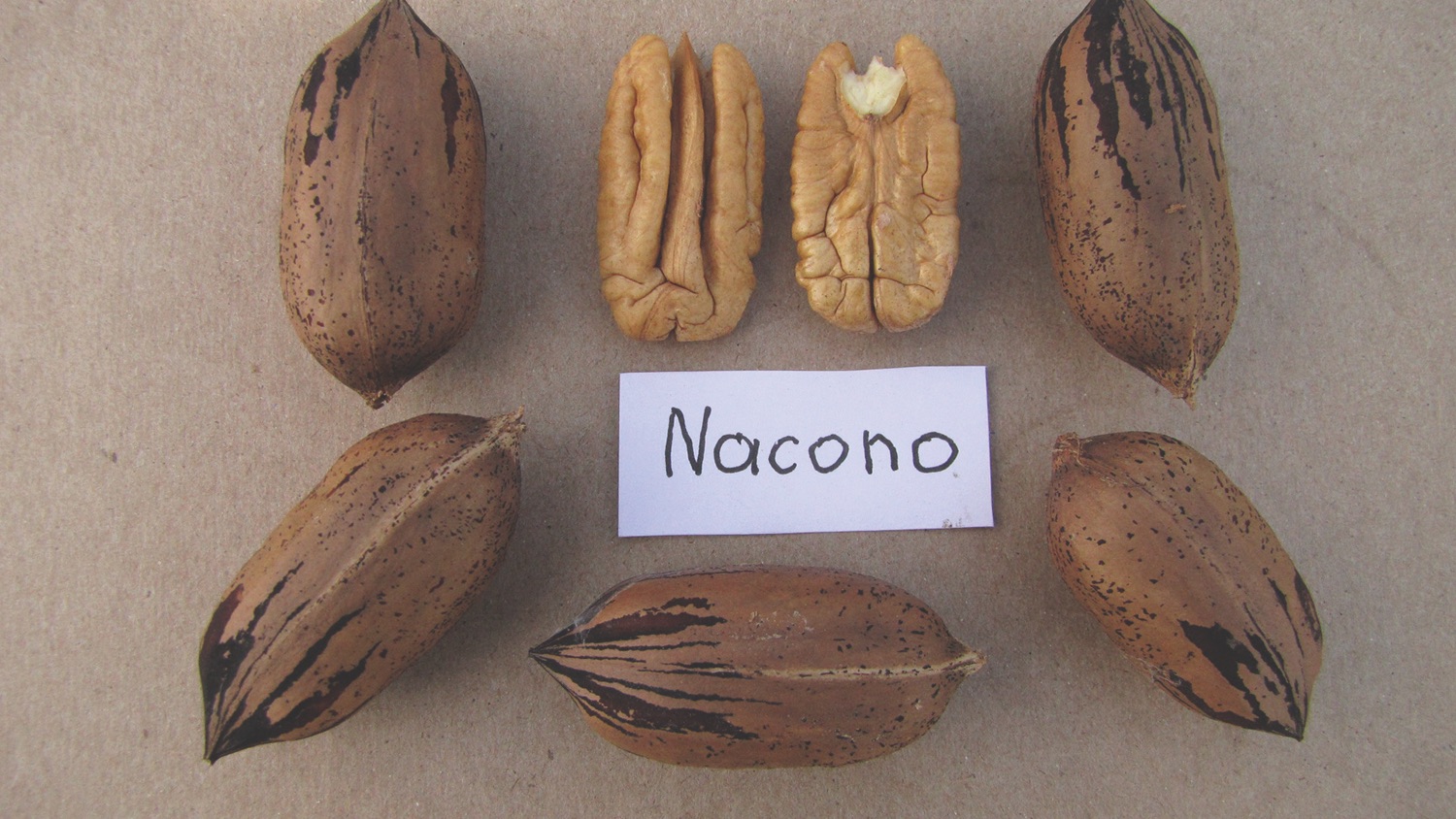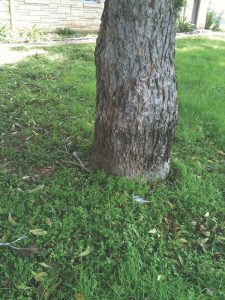Pecan Variety Identification

Coloration patterns on the shell surface differ among varieties. (Photo by Monte Nesbitt)
Buyers routinely receive mixed lots of pecans and need to identify them. Pecan shows in Texas commonly have misidentified samples. Pecan variety identification can be a challenge, even for experienced growers looking at nuts they aren’t familiar with. The common response we hear from people who are new to pecan varieties is, “They all look alike. How do you tell them apart?” The answer that I give is—practice.
With familiarity and experience, the observer can find distinctions in the nuances in pecan shell shape and kernel characteristics in addition to tree form, bark, and the tree’s other growth characteristics. For someone new and unpracticed in pecan variety identification, there are helpful hints and resources that even the experts use to bring an obscure variety into sharper focus.
Estimate Tree Age
There are 1,012 pecan varieties listed in Thompson and Young’s book, Pecan Cultivar’s-Past and Present (1985, Texas Pecan Growers Association), and it doesn’t pretend to capture all of the named natives and local seedling selections that have come and gone in the United States. The list of possible varieties can be narrowed by considering the age of the tree or trees in question. If it is an old tree that dates to the 1940s or before, old varieties like ‘Frotscher’ (1882), ‘Van Deman’ (1877), ‘Teche’ (1906), ‘Moneymaker’ (1896) and their contemporaries that were planted in the early decades of the 20th Century are comparisons to consider.
For trees planted from the 1940s to 1960s, ‘Stuart’ (1886), ‘Success’ (1903), ‘Mahan’ (1927), and of course, ‘Desirable’ (1948) were among the most popular in the Southeast and elsewhere. The earliest USDA selection, ‘Barton,’ was released in 1953, followed by 14 other varieties released from the 1950s to the 1970s, including ‘Choctaw,’ ‘Wichita,’ and ‘Cheyenne.’ New releases from USDA from the 1980s to present and other sources have been well documented since that time, which helps pinpoint the appearance and popularity of pecan varieties for particular growing regions.
Grafted, Seedling, or Native?
Whether or not a tree was grafted to an improved variety provides an important clue when determining if a tree can be matched or identified. Changes in bark texture (see photo) indicate a tree was grafted at least once. Some graft unions can be more subtle or harder to discern on older trees. If, with careful study of the tree form, the tree’s location and known history, there is no evidence it was grafted, it may be classified as a unique native tree or variety seedling, unless its nut and kernel traits closely match that of a named variety. Separating variety seedlings from natives requires additional study of the site, the potential influence of people, and the nut characteristics themselves.
Pollinators
The knowledge that pecan varieties differ in pollination habits (Type I/protandrous and Type II/protogynous) can be a useful clue for pecan variety identification. ‘Wichita’ (II) and ‘Western’ (I) are complimentary pollinating varieties and thus frequently planted together in the West. ‘Stuart’ (II) and ‘Success’ (I) or ‘Desirable’ (I) were planted together for pollination in the East. So within growing regions, we expect to see certain blends of Type I and Type II varieties together in commercial orchards, which may help unravel unidentified pecan trees more quickly.
Nut Shape and Features
Pecan nut shape among different varieties is very diverse. From distinctly round/orbicular shapes like ‘Burkett’ to elliptical/”football-esque” forms like ‘Caddo’ or oblong shapes like ‘Schley’ and ‘Mahan,’ there are many variations. Although problems like drought and pecan scab can distort it, pecan nut shape is fixed genetically by variety and thus an important key to identification.
Four distinguishing characteristics have to be considered: a) overall nut shape when looking at the nut from tip to base — oblong, oval, etc.; b) the nut tip (apex) — some are acute, others obtuse, acuminate, etc.; c) the nut basal end (base) also varies in characteristic shape; and d) the appearance of the nut in cross-section may be flattened, round or other. When there is confusion or doubt about a variety’s true identification, carefully considering all 4 points will separate similar varieties. L.J. Grauke and Tommy Thompson established detailed descriptors for these characteristics, which may be found on their “Pecan Cultivar Index.”
Along with shape indices, overall size is another distinguishing feature of outward nut appearance. The number of nuts per pound is a weight-based indicator of size. While it can be affected by water availability, crop load, and other cultural practices, the nut size of an unknown variety is a useful value. Large nut varieties, like ‘Pawnee,’ can be reduced in size if crop load is heavy and water is short, but small nut varieties generally have a limit on how big they can become under the best of circumstances. ‘Elliott,’ for example, is commonly a 67 to 72 nuts-per-pound variety. ‘Elliott’ can be as heavy as 57 to 62 per pound, but unlikely that it could reach 47 to 52 per pound. So, nut size can help when identifying pecan varieties.
Many people ask about shell markings as an identifying trait. These dark patterns of coloration on the shell surface (see the photo of ‘Nacono’) are genetic and differ among varieties. But their appearance is highly variable and they are easily buffed off with the handling of the nuts. Thus, shell markings used little as a trait for variety identification. However, the shell’s texture—some are more rough/pebbly than others—and thickness are important features that help separate varieties.
Kernel Characteristics
The appearance of kernels is useful in pecan variety identification. The surface texture of the kernels, the depth and width of ventral and dorsal grooves, along with the apex-end and basal-end shapes are genetically-controlled distinguishing features. ‘Cheyenne’ has a lot of wrinkles or creases in the kernel surface texture, while ‘Sioux’ is one of the smoothest. ‘Forkert’ is a variety that has narrow grooves that tend to trap packing material.
Kernel color likewise varies among varieties, with a range in the spectrum of pale cream like ‘Hopi’ to dark beige like ‘McMillan.’ Speckles, as seen in ‘Burkett’ and sometimes in ‘Pawnee,’ may help identify a pecan.
Another distinguishing trait is the percentage of edible kernel in a nut sample. As with nut weight, kernel percentage can be positively or negatively affected by water, crop load, and other growing conditions. Like nut weight, there are genetic limits on what a particular variety can achieve in percent kernel. ‘Desirable’ and ‘Kiowa’ (an offspring of ‘Desirable’) are hard to separate visually when looking only at nut shape and nut size. They are frequently misidentified as one another in pecan shows in Texas. One way to separate them is with percent kernel value. ‘Desirable,’ at its best runs 52, 53, maybe 54 percent kernel. ‘Kiowa’ in contrast will reach 57/58 percent kernel, and that 4-5 percentage point difference is meaningful for identification. Of course, the trees of ‘Kiowa’ and ‘Desirable’ have very different growth habits and canopy forms, making them easy to distinguish from one another.
Consult an Expert
It may be necessary to seek out someone with lots of practice in pecan identification. Most university horticulturists who work with pecans — even some entomologists and plant pathologists — can help with pecan variety identification. Pecan buyers, accumulators, and shellers also qualify as experts in this discussion. They encounter lots of different pecan varieties, grown in many settings, and scrutinize them because their profitability from pecan sales depends on it.
Experienced pecan growers also can offer help with identification. Today, at the highest level of help is the USDA Pecan Breeding and Genetics Laboratory, located in Somerville, Texas. L.J. Grauke is the curator of the Carya germplasm collection. They maintain a large library of samples, and Grauke’s expertise includes molecular markers-DNA analysis of pecans, with which he has been able to show relatedness among varieties and conclusively sort out unknown or misidentified trees.
Comparative References
Comparing unidentified pecan varieties to known, verified samples is a sound approach if available. In the absence of samples, pictures are very helpful. The USDA website mentioned above includes a pecan cultivar index and pecan photo index, which has a consistent format of nut and kernel photos useful for identification and remains a tremendous resource to the industry. Thompson and Young’s book also includes photos of a portion of the varieties in the book. Additional references include, among others, the University of Georgia Southeastern Pecan Growers’ Handbook (Wells, et al., 2007) and Darrell Spark’s book, Pecan Cultivars: the Orchard’s Foundation (Pecan Productions Innovations, 1992). Spark’s book includes a key, based on nut shapes, that identifies selected pecan varieties.


